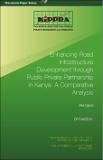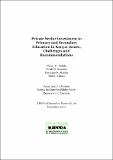| dc.date.accessioned | 2023-02-22T09:14:04Z | |
| dc.date.available | 2023-02-22T09:14:04Z | |
| dc.date.issued | 2007 | |
| dc.identifier.uri | https://repository.kippra.or.ke/handle/123456789/4077 | |
| dc.description.abstract | The growth of private education provision since
the 1990s can be associated with various factors,
including education policy reforms such as the
introduction of cost sharing in 1988, curriculum
reform from the 7-4-2-3 to 8-4-4 system of education
in 1985, and commitment to Universal Primary
Education (UPE) and Education for All (EFA) goals
starting in 1990 and its renewed emphasis in the
year 2000. The private sector providers of education
comprise profit and non-profit organizations mainly
financed and managed by individuals, communities,
non-governmental organizations, private companies
and others. | en |
| dc.language.iso | en | en |
| dc.publisher | The Kenya Institute for Public Policy Research and Analysis (KIPPRA) | en |
| dc.relation.ispartofseries | Policy Brief;No. 17 of 2007 | |
| dc.subject | Private Sector Participation | en |
| dc.subject | Primary and Secondary Education | en |
| dc.subject | Private-Public Patnership | en |
| dc.subject | Professional Development Programmes | en |
| dc.subject | Education | en |
| dc.title | Policy Brief No. 17 of 2007 on Enhancing Private Sector Participation in the Provision of Primary and Secondary Education in Kenya | en |
| dc.type | Other | en |
| ppr.contributor.author | The Kenya Institute for Public Policy Research and Analysis (KIPPRA) | en |




